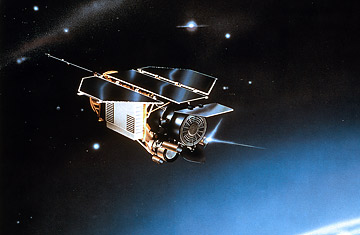
An artist impression of the ROSAT satellite in space.
If you knew what was going on above your head, you probably wouldn't sleep at night. It was 54 years ago this week that the first satellite — Russia's little Sputnik — went into orbit, and in the half-century since, we've made travel to near-earth space largely routine. That, by almost any measure, is a good thing, but like so many good things human beings build or do or achieve, a very bad thing comes along with it: junk.
For every spacecraft that goes into orbit, all kinds of rubbish — bolts, boosters, adapter rings, insulation, even paint chips — are also released. Five decades of that kind of littering has created a very big mess: according to tallies from NASA, NORAD (North American Aerospace Defense Command), the Federal Communications Commission and other domestic and international agencies, there are currently 17,000 objects measuring 4 in. (10 cm) or greater circling the earth. There are a whopping 200,000 in the 1-in. to 3-in. (2.5 cm to 7.5 cm) range, and millions smaller than an inch.
Many of those objects in the largest category are much, much larger than a mere 4 in. (10 cm). Indeed, they are entire spacecraft themselves. Aged satellites — some the size of a school bus and weighing on the order of tons — that have outlived their usefulness often wind up simply drifting through space like an abandoned barge. In late September, a 6-ton NASA research satellite, launched in 1991, came plummeting home, falling safely into the south Pacific, but not before causing a lot of scientists a lot of jitters as they watched the roulette wheel of the satellite's orbit, trying to calculate just when and where the ship would lose enough energy to drop from the sky. No sooner had that scare ended than the German space agency announced that a 2.5-ton space telescope called ROSAT would be tumbling home sometime in late October or early November — landing spot still unknown. In August, problems with Russia's Soyuz booster, which is the only space taxi American astronauts currently have, triggered a lot of talk about whether the International Space Station (ISS) would have to be abandoned, causing the entire 357-ft. (109 m) facility to plunge back to earth.
The ISS is not going anywhere soon, thanks to onboard boosters that can stabilize and raise its orbit, but the rest of the junk will ultimately go down, if it doesn't collide with another spacecraft first — a whole other category of possible calamity. Just such a cosmic crack-up occurred in 2009 between decommissioned American and Russian satellites, an accident that would have been instantly fatal if one or both of the vehicles had been inhabited.
The very enormity of the debris belt would seem to make many more such accidents inevitable, but as TIME reported after the 2009 collision, the risk is minimized by the fact that all objects orbiting at the same altitude also move at the same speed — 17,500 m.p.h. (28,200 km/h). That means they're essentially standing still relative to one another. To close the gap between two objects, as, say, a Soyuz spacecraft does when approaching the ISS, it's necessary to change that relative speed — in this case, by the Soyuz tweaking its thrusters to accelerate ever so slightly. Relative to the station, it's moving at a very safe crawl, just enough to nose into a docking port.
